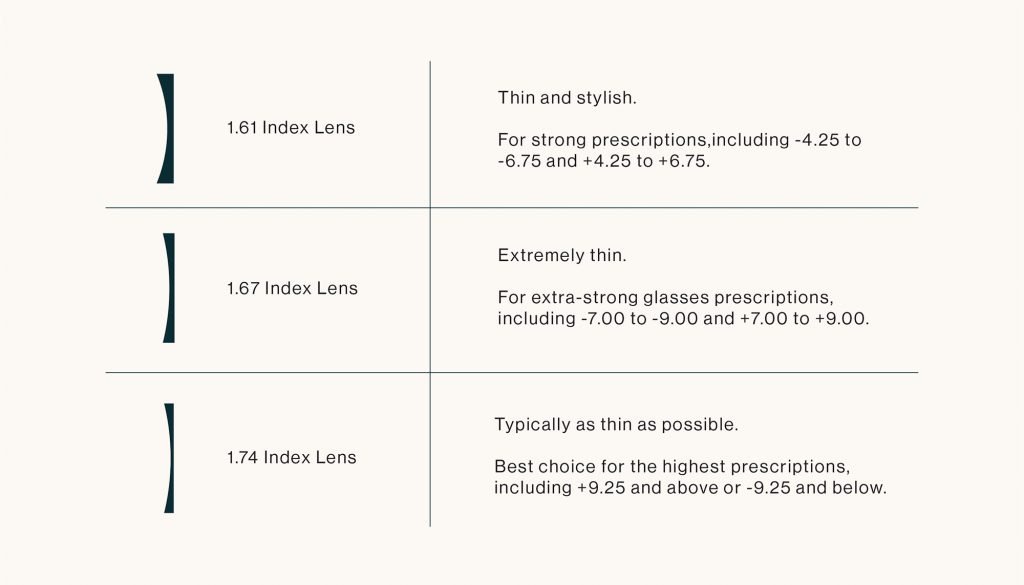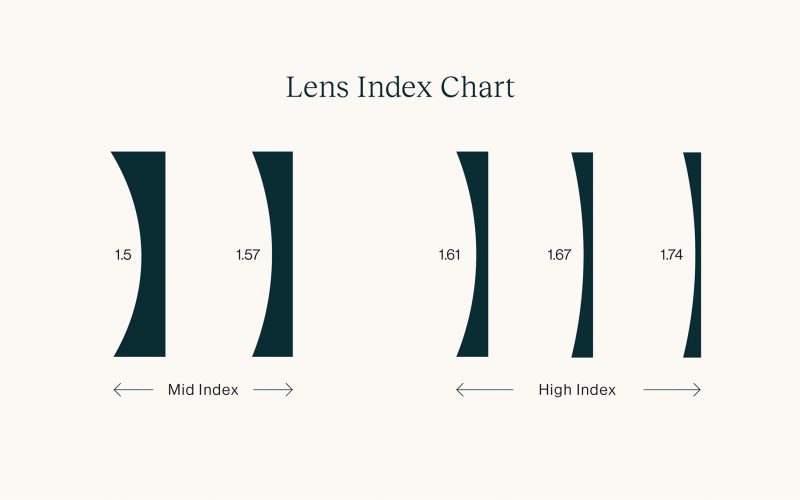While you are shopping for your next pair of glasses, you might see the term “lens index.” But what exactly does it mean, and what are the different types of lenses? Understanding the different numbers and how they relate to your eyesight is crucial when buying new glasses.
This guide discusses everything you need to know about the lens index and 1.57 mid index lenses, including standard or mid-index lenses, high index lenses vs. polycarbonate, and more.
What Does Lens Index Mean?
So what exactly is the lens index? The lens index, also known as the “refractive index” or the “index of refraction,” is the measurement of how efficiently the lens bends light. As the strength of your glasses prescription increases, the lenses tend to get heavier and thicker.
Higher-index material offers lighter and thinner glasses lenses, making them an excellent option for glasses wearers with a strong prescription. The lens index numbers usually range from 1.50 to 1.74.
1.50 vs. 1.57 Mid Index
What is the difference between 1.50 standard vs. 1.57 mid index lenses? The 1.50 standard index lenses are the thickest lenses you can buy for a standard pair of prescription glasses. These lenses work best for light prescriptions that have superior clarity and fall between -3.00 and +3.00. Due to the conventional 1.50 single-vision index lens properties, the glasses need to be a full-rim frame. This type of frame supports all sides of the lens to reduce and prevent cracking.
The 1.50 standard index plastic lenses were the first alternative to glass lenses. While it is a worthwhile alternative for some glasses wearers, these lenses need to be coated because they don’t block UV radiation well, and they scratch relatively easily.
The 1.57 mid index lenses are meant for people with moderately strong prescriptions, and they are thinner and lighter than standard lenses. The lens is a polycarbonate composite made from polycarbonate, other polymers, and resins that keep it thinner and lighter than the standard 1.50 lens.
High Index
What Are High Index Lenses?
What exactly are high index lenses, and what are the differences between polycarbonate vs. high index lenses? Higher prescriptions require high index lenses to keep them thin and light. The higher a lens’ index number, the thinner it becomes. High index lenses tend to be very stylish and lightweight and are meant for glasses wearers with high prescriptions.

1.61 vs. 1.67 vs. 1.74
Are you wondering what the differences are between the 1.61 vs. 1.67 vs. 1.74 high index lenses? We’ll break it down for you:
- 1.61 high index lenses. The 1.61 high index lenses are thin and stylish. They are an excellent choice for strong prescriptions, including -4.25 to -6.75 and +4.25 to +6.75. This index works well with full-rim plastic and acetate, full-rim metal, half-rim, and rimless frames.
- 1.67 high index lenses. The 1.67 high index lenses are extremely thin, so they are an excellent option for extra-strong glasses prescriptions, including -7.00 to -9.00 and +7.00 to +9.00. This index works well with full-rim plastic and acetate, full-rim metal, half-rim, and rimless frames.
- 1.74 high index lenses. The 1.74 high index lenses are typically as thin as possible and the best choice for the highest prescriptions, including +9.25 and above or -9.25and below. This option works well with full-rim plastic, acetate, and metal frames.
Trivex vs. Polycarbonate
Want to know the differences between Trivex and polycarbonate lenses? Trivex 1.53 lenses are very lightweight, suitable for all types of frames, and excellent for kids and sports. They have superior clarity and impact resistance.
Polycarbonate 1.59 lenses are also suitable for all types of frames and are impact-resistant, making them another great option for kids. While Trivex 1.53 lenses are best for Rx range +2.00/-3.00 or below, polycarbonate 1.59 lenses are best for Rx range +3.00/-4.75 or above for children ages 18 and under.
Other Factors to Consider Besides Rx
Prescription is not the only factor to consider when determining which lenses are the right option for you. You should also consider pupillary distance, frame type, and your lifestyle needs.
- Pupillary distance. Your pupillary distance, also known as your PD, is the distance between each pupil and the center of the bridge of your nose. A smaller than average pupillary distance often requires digital free-form lenses rather than standard lenses.
- Frame type. Depending on the type of frames you choose, you might need to select a particular index.
- Lifestyle needs. If your daily routine involves intense exercise or labor, you probably want a more durable index.
If you want more information about our lens technology, including our state-of-the-art computer glasses, please contact Felix Gray to learn more. We can also help you with your non-prescription eyeglass needs as well.
